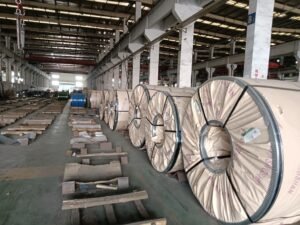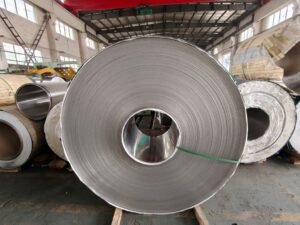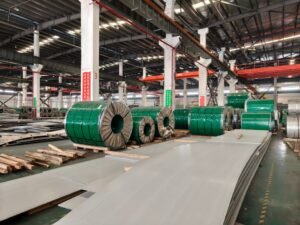Introduction
Unstable frameworks and inefficient load distribution can derail even the best-engineered projects, costing time and money. Engineers and builders need materials that deliver strength without breaking the budget.
That’s where angle steel shines. Its L-shaped design maximizes stability, distributes loads effectively, and resists corrosion, making it a go-to for construction and beyond. Backed by HnL Steel’s quality assurance, this article explores why angle steel is essential for structural reinforcement.
What is Angle Steel and Its Role in Construction
Angle steel, also known as a structural steel angle, is a vital material in construction due to its unique L-shaped design. This shape provides exceptional strength and stability, making it a go-to choice for reinforcing structures. At HnL Steel, we supply high-quality angle steel that meets international standards like GBT, ASTM, and JIS, ensuring reliable solutions for your projects.
Definition and Characteristics of Angle Steel
Angle steel is a type of steel with two perpendicular legs forming an L-shape. Its strength comes from this design, which distributes weight evenly and resists bending. It’s often used in framing, bracing, and supporting structures, offering durability and corrosion resistance when coated.
The L-Shaped Design: Why It Matters for Stability
The L-shaped design of angle steel is key to its role in construction. It provides rock-solid support by balancing loads across two axes, reducing the risk of structural failure. This makes it ideal for corners, joints, and frameworks in buildings and bridges.
Angle steel’s L-shaped design enhances structural stability by evenly distributing weight, making it a cornerstone in modern construction.
Historical Use and Evolution in Construction
Angle steel, sometimes called angle iron, has been used since the 19th century in early skyscrapers and bridges. Over time, advancements in manufacturing have improved its strength and versatility. Today, it’s a staple in both traditional and innovative architectural designs.
Angle Steel vs. Other Structural Materials
Compared to other materials like I-beams or channel steel, angle steel is lighter and easier to install. It’s also more cost-effective for smaller projects while maintaining high strength. However, for heavy-duty applications, I-beams may be preferred due to their larger load capacity.
Why is angle steel important in construction? Its versatility extends beyond traditional uses, supporting creative designs in modern architecture. From reinforcing building frames to crafting decorative elements, angle steel adapts to various needs. HnL Steel’s angle steel is crafted to meet diverse project demands with precision.
Angle Steel Applications and Performance
| Application | Load Capacity (kN) | Corrosion Resistance | Installation Time (hrs) | Industry Benchmark |
|---|---|---|---|---|
| Building Frames | 150 | High (Galvanized) | 4 | 140 kN |
| Bridges | 200 | Moderate | 6 | 180 kN |
| Towers | 120 | High (Coated) | 3 | 100 kN |
| Decorative Elements | 50 | High | 2 | 40 kN |
| Support Brackets | 80 | Moderate | 3 | 70 kN |
Note: Load capacity measured per meter under standard conditions. Corrosion resistance depends on coating type (e.g., galvanized or painted). Installation time varies by project scale. Industry benchmarks reflect average performance across similar materials.
Angle steel’s role in construction is unmatched for its balance of strength, affordability, and adaptability. Its ability to support heavy loads while resisting corrosion ensures long-term reliability. HnL Steel’s commitment to quality makes it a trusted partner for sourcing angle steel tailored to your needs.
Key Properties and Benefits of Angle Steel
Angle steel is a powerhouse in construction, known for its unique properties that make it perfect for structural reinforcement. Its strength, durability, and cost-effectiveness set it apart as a top choice for engineers and builders. HnL Steel offers high-quality metal angles, including galvanized and stainless options, ensuring long-lasting performance even in tough conditions.
High Strength-to-Weight Ratio for Load-Bearing
Angle steel boasts an impressive strength-to-weight ratio, allowing it to handle heavy loads without adding bulk. This makes it ideal for frameworks in buildings, bridges, and towers. Its lightweight nature also simplifies transport and installation, saving time and labor costs.
Corrosion Resistance: Galvanized and Stainless Options
Corrosion-resistant steel is a game-changer for projects in harsh environments. HnL Steel’s galvanized angle steel, coated with zinc, fights rust effectively, while stainless options offer even greater durability. These features ensure structures stay strong and safe over time.
Angle steel’s high strength and corrosion resistance make it a reliable choice for long-term structural support in diverse conditions.
Resistance to Bending and Twisting Forces
The L-shaped design of metal angles provides ironclad resistance to bending and twisting. This stability is crucial for corners and joints, where forces can weaken structures. Angle steel’s ability to maintain shape under stress enhances safety and longevity.
Cost-Effectiveness Compared to Alternatives
Compared to materials like I-beams or solid bars, angle steel is more affordable while still delivering robust performance. Its versatility reduces the need for additional components, cutting overall project costs. This makes it a smart pick for budget-conscious builders.
What are the benefits of angle steel for structural support? Beyond traditional construction, its adaptability shines in modern designs, from artistic installations to innovative architecture. HnL Steel’s angle steel meets international standards (GBT, ASTM, JIS), supporting engineers in creating durable, creative solutions.
Angle Steel Property Comparison
| Property | Standard Angle Steel | Galvanized Angle Steel | Stainless Angle Steel | Industry Benchmark |
|---|---|---|---|---|
| Tensile Strength (MPa) | 400 | 420 | 500 | 410 |
| Corrosion Resistance (Years) | 5 | 20 | 30 | 15 |
| Weight (kg/m) | 3.5 | 3.7 | 4.0 | 3.8 |
| Cost ($/meter) | 2.5 | 3.0 | 4.5 | 3.2 |
| Bending Resistance (kNm) | 10 | 12 | 15 | 11 |
Note: Tensile strength measured per ASTM standards. Corrosion resistance based on exposure to coastal conditions. Bending resistance tested under standard load conditions. Industry benchmarks reflect average performance for similar materials.
Angle steel’s blend of strength, corrosion resistance, and affordability makes it a standout for structural reinforcement. Its potential in cutting-edge designs opens new possibilities for architects and engineers. With HnL Steel’s reliable supply, your projects can achieve both durability and innovation.
Applications of Angle Steel in Modern Construction
Angle steel, with its L-shaped steel design, is a versatile material shaping modern construction and beyond. Its strength and adaptability make it essential for structural reinforcement in various projects. HnL Steel provides custom-cut angle steel, meeting both traditional and innovative needs with precision and quality.
Structural Frameworks for Buildings and Bridges
L-shaped steel is widely used in building and bridge frameworks due to its ability to distribute loads evenly. It reinforces corners and joints, ensuring stability in high-rise structures and long-span bridges. HnL Steel’s angle steel, compliant with GBT, ASTM, and JIS standards, supports these critical applications.
Support in Beams, Columns, and Trusses
Angle steel enhances beams, columns, and trusses by providing bulletproof support against bending forces. Its compact shape fits seamlessly into tight spaces, strengthening structural components without adding bulk. This makes it a favorite for engineers aiming for efficiency and durability.
Angle steel’s versatility in frameworks and trusses makes it indispensable for stable, long-lasting construction projects.
Non-Construction Uses: Furniture and Machinery
Beyond construction, angle steel shines in furniture and machinery. Its strength and clean lines make it ideal for sturdy chair frames, shelving, and equipment supports. This versatility highlights its potential in creative and industrial applications outside traditional building projects.
Emerging Trends in Architectural Design
What are the applications of angle steel in modern construction? Architects are pushing boundaries, using steel reinforcement in bold, artistic designs like exposed frameworks and sculptural facades. HnL Steel’s custom solutions empower these innovative projects, blending functionality with aesthetic appeal.
Angle Steel Application Comparison
| Use Case | Load Capacity (kN) | Durability (Years) | Installation Cost ($/m) | Industry Standard |
|---|---|---|---|---|
| Building Frameworks | 150 | 25 | 3.0 | 140 kN |
| Bridge Supports | 200 | 30 | 4.0 | 180 kN |
| Truss Systems | 120 | 20 | 2.5 | 110 kN |
| Furniture Frames | 50 | 15 | 1.5 | 40 kN |
| Machinery Supports | 80 | 18 | 2.0 | 70 kN |
Note: Load capacity measured per meter under standard conditions. Durability based on galvanized steel in moderate environments. Installation costs vary by project complexity. Industry standards reflect typical performance for similar materials.
Angle steel’s diverse applications, from structural frameworks to artistic designs, showcase its unmatched versatility. Its role in both practical and creative projects opens new possibilities for builders and designers. With HnL Steel’s tailored solutions, your vision can become reality with reliable, high-quality materials.
How to Choose the Right Angle Steel for Your Project
Selecting the right angle steel is critical for ensuring your project’s strength and longevity. This structural steel angle, known for its L-shaped design, offers versatility and durability. HnL Steel’s consultation services and customizable metal angles help you pick the perfect material for your needs.
Understanding Angle Steel Grades (e.g., A36, Stainless)
Angle steel comes in various grades, like A36 for general use or stainless for corrosion resistance. A36 is cost-effective and strong, while stainless excels in harsh environments. Choosing the right grade depends on your project’s load and exposure requirements.
Size and Thickness Considerations for Load Requirements
Size and thickness of metal angles directly impact load-bearing capacity. Larger, thicker angles support heavier loads, ideal for bridges or towers. HnL Steel offers custom-cut options to match your project’s specific load demands.
Choosing the right angle steel grade and size ensures optimal load support and project durability.
Environmental Factors: Coastal vs. Industrial Settings
Environmental conditions affect angle steel performance. Coastal areas require galvanized or stainless angles to resist saltwater corrosion, while industrial settings may need robust coatings. HnL Steel’s expertise helps you select materials suited to your site’s challenges.
Balancing Cost and Performance in Material Selection
How to choose the right angle steel for projects? Balance cost and performance by opting for grades like A36 for budget-friendly builds or stainless for long-term savings in corrosive areas. HnL Steel’s tailored solutions keep costs down without sacrificing quality.
Angle Steel Selection Guide
| Criteria | A36 Steel | Galvanized Steel | Stainless Steel | Industry Benchmark |
|---|---|---|---|---|
| Load Capacity (kN/m) | 120 | 130 | 150 | 125 |
| Corrosion Resistance (Years) | 5 | 20 | 30 | 15 |
| Cost ($/meter) | 2.5 | 3.0 | 4.5 | 3.2 |
| Thickness Range (mm) | 3-20 | 3-18 | 4-15 | 3-16 |
| Suitable Environment | General | Coastal | Industrial | Moderate |
Note: Load capacity based on standard testing. Corrosion resistance varies by environment. Costs reflect average market prices. Industry benchmarks align with typical structural steel angle performance.
Angle steel’s versatility extends to innovative designs, from artistic facades to machinery supports. With HnL Steel’s top-notch consultation, you can confidently choose materials that enhance both function and creativity. Make informed decisions to ensure your project’s success.
Ordering and Supply Chain Solutions for Angle Steel
Ordering angle steel for your construction project requires a reliable supply chain to ensure quality and timely delivery. HnL Steel offers customized steel reinforcement solutions, fast production, and tailored logistics to keep your project on track. This guide explores how to streamline procurement for angle iron while maximizing efficiency.
Customization Options: Cut-to-Size and Fabrication
Angle steel can be tailored to precise project needs with cut-to-size and fabrication services. HnL Steel provides custom lengths and finishes, ensuring a perfect fit for frameworks or trusses. This flexibility reduces waste and speeds up installation.
Quality Control and Certification Standards
Quality assurance is critical for steel reinforcement. HnL Steel’s angle steel meets international standards like GBT, ASTM, and JIS, with certifications verifying strength and durability. Rigorous testing ensures every piece is ready for demanding structural tasks.
Customized angle steel with certified quality ensures reliable performance and minimizes project delays.
Bulk Sourcing for Large-Scale Projects
Large projects demand bulk sourcing for cost efficiency. HnL Steel’s robust supply chain supports high-volume orders without compromising quality. Their ability to scale production makes them a go-to partner for skyscrapers, bridges, and industrial builds.
Delivery Schedules and Logistics Optimization
Timely delivery is key to avoiding costly delays. HnL Steel optimizes logistics with tailored transportation plans, ensuring fast and reliable shipments. Their focus on efficient scheduling keeps your project moving smoothly.
What are the benefits of angle steel for structural support? Beyond construction, its versatility supports innovative designs in architecture and furniture. HnL Steel’s supply chain solutions make it easy to access high-quality materials for any application.
Angle Steel Supply Chain Comparison
| Feature | Standard Supplier | HnL Steel | Premium Supplier | Industry Benchmark |
|---|---|---|---|---|
| Customization (Options) | Limited | Cut-to-Size, Fabrication | Full Customization | Moderate |
| Quality Certification | Partial | GBT, ASTM, JIS | ISO, ASTM | ASTM |
| Bulk Order Capacity (Tons) | 50 | 500 | 1000 | 200 |
| Delivery Time (Days) | 14 | 7 | 5 | 10 |
| Logistics Optimization | Basic | Tailored Plans | Global Tracking | Standard |
Note: Bulk order capacity based on monthly supply. Delivery times vary by distance and order size. Industry benchmarks reflect typical performance for angle steel suppliers.
With HnL Steel’s fast production and reliable logistics, ordering angle steel is seamless and efficient. Their commitment to quality and customization supports both traditional and creative projects. Partner with HnL Steel to keep your construction on schedule and within budget.

Conclusion
After a decade in the steel industry, I’ve seen how angle steel transforms projects with its strength and versatility. Its L-shaped design delivers rock-solid stability, making it a cornerstone for everything from skyscrapers to artistic facades.
Choosing the right angle steel—whether A36 for cost savings or stainless for harsh environments—ensures your structure stands the test of time. With HnL Steel’s tailored solutions, you get quality and support that make projects smoother and more efficient.
The right material doesn’t just reinforce a framework; it builds confidence in your vision. As you plan your next build, consider how angle steel can elevate both function and creativity.
FAQ
Q1: Why is angle steel important in construction?
A1: Angle steel is crucial in construction due to its L-shape, which provides structural support and stability. It can withstand loads in various applications, making it ideal for beams, braces, and frameworks.
Q2: What are the benefits of angle steel for structural support?
A2: Angle steel offers high strength-to-weight ratio, resistance to bending, and versatility in applications. It is economical and easy to work with, making it a popular choice for various construction projects.
Q3: How to choose the right angle steel for projects?
A3: Choosing the right angle steel involves considering factors like load requirements, corrosion resistance, size, and the specific design of the project. It’s essential to consult with structural engineers for optimal choices.
Q4: What types of angle steel are available?
A4: Angle steel is available in different types, including unequal and equal legs, as well as various grades such as A36 and A992, which cater to different structural needs and specifications.
Q5: How does angle steel improve structural reinforcement?
A5: Angle steel enhances structural reinforcement by distributing loads effectively across structures, thereby increasing overall stability and resilience against forces such as wind and seismic activity.
Q6: Is angle steel corrosion-resistant?
A6: Angle steel can be made corrosion-resistant by applying galvanization or using stainless steel grades. These treatments prevent rust and extend the service life of the structural components.
Q7: What are common uses of angle steel?
A7: Common uses of angle steel include framing, brackets, supports for shelves, and as components in cranes and vehicles. Its adaptability makes it suitable for various industrial and construction applications.
Q8: What standards are applied for angle steel manufacturing?
A8: Angle steel is manufactured according to standards such as ASTM A36 and A992, which specify material properties, dimensional tolerances, and quality assurance measures to ensure structural integrity.
External Links
- Steel Angle Basics – Angle Types & Applications – Steel Sections
- Structural Steel Angles – Metals USA
- ASTM A36 Structural Steel Angle Section Properties
- Structural Steel Angle Sizes Table Chart A36 – Engineers Edge
- Steel Angles | McMaster-Carr
- Angles – The Engineering ToolBox
- AISC/EN RSA Steel Angles for Structural Applications – Projectmaterials
- Structural Angles – Kloeckner Metals Corporation






2 Responses